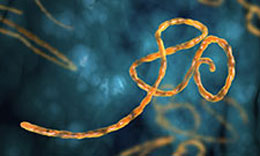Update on Resurgence of Ebola
BY ALLISON KOZICHAROW; EDITED BY BERNICE BORN
T
 Sketch of Ebola virus Sketch of Ebola virus
he Ebola virus returned to the Democratic Republic of the Congo in August 2018. Today the World Health Organization (WHO) and the DR Congo’s Ministry of Health continue to combat Ebola — despite violent disturbances and the killing of civilians carried out by rebelling militiamen.
In response to the Ebola outbreak in West Africa five years ago, WiRED International produced the first computer-based, expertly written, peer-reviewed Ebola training modules, which developed into a prevention education program throughout Africa. WiRED offers four Ebola modules which have been translated into French. They have been written for both healthcare professionals and for general audiences.

Read More

To date, in the DR Congo there have been 608 cases of Ebola and 368 deaths. More than 54,000 high-risk individuals and frontline responders have been vaccinated, and almost every new patient receives one of four investigational treatments (experimental drugs), something which was never previously possible during an Ebola outbreak. A key strategy for stemming a rapid escalation in the number of cases is to halt the epidemic early, before the virus can take a strong foothold in the population, then spread like wildfire across continents.
WiRED is often a first responder in providing education to enable a local population to address the immediate health situation and establish an ongoing information and training support presence. WiRED is presently developing a community health worker project, which will train individual communities to configure a curriculum that best meets the needs of their populations, whether fighting Ebola or addressing other health and disease topics.
WiRED will continue to monitor and report on the ongoing situation in West Africa.

What is Ebola?
- Ebola virus disease (EVD), formerly known as Ebola hemorrhagic fever, is a severe, often fatal illness in humans.
- The virus is transmitted to people from wild animals and spreads in the human population through human-to-human transmission.
- The average EVD case fatality rate is around 50%. Case fatality rates have varied from 25% to 90% in past outbreaks.
- The first EVD outbreaks occurred in remote villages in Central Africa, near tropical rainforests. The 2014–2016 outbreak in West Africa involved major urban areas as well as rural ones.
- Community engagement is key to successfully controlling outbreaks. Good outbreak control relies on applying a package of interventions, namely case management, infection prevention and control practices, surveillance and contact tracing, a good laboratory service, safe and dignified burials and social mobilization.
- Early supportive care with rehydration and symptomatic treatment improves survival. There is as yet no licensed treatment proven to neutralize the virus, but a range of blood, immunological and drug therapies are under development.
Source: WHO

You can download the modules mentioned in this story, and all 400+ of WiRED’s health modules, through WiRED’s Health Module Access Program (HealthMAP) by clicking here. This easy-to-use free program will enable you to create your own customized collection of health learning modules. You can learn more about HealthMAP through WiRED's animation.


^ Back to the Top
|





